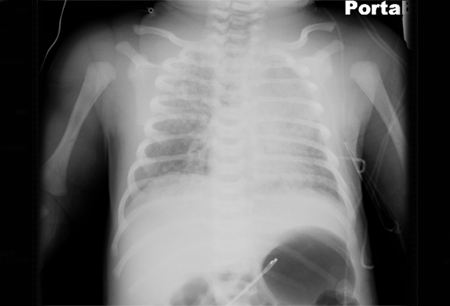Summary
Definition
History and exam
Key diagnostic factors
- presence of risk factors
- signs of post-maturity
- tachypnoea
- cyanosis
- chest wall asymmetry with decreased air entry
- barrel-shaped chest
Risk factors
- gestational age >42 weeks
- pregnancy-induced hypertension
- maternal diabetes mellitus
- maternal smoking or substance misuse
- fetal distress
- oligohydramnios
- thick meconium
- Apgar score <7
- chorioamnionitis
- caesarean delivery
- black ancestry
- male sex
Diagnostic investigations
Investigations to consider
- dual pulse oximetry
- ABG (pH, PaO₂, PaCO₂)
- echocardiography
- cranial ultrasound
- electroencephalogram
- urinalysis
Treatment algorithm
Contributors
Authors
Dharmapuri Vidyasagar, MD, MSc, FAAP, FCCM, PhD (Hon)

Professor Emeritus
Department of Pediatrics
University of Illinois at Chicago
Chicago
IL
Visiting Professor
Department of Neonatology
Sri Ramachandra Medical College
Chennai
India
Disclosures
DV is an author of a number of references cited in this topic. He has received royalties for editing the following books: Neonatal Ventilation (Elsevier India), Practical Neonatology (Indian Journal of Pediatrics), and Perinatal Cardiology (Cambridge Scholar publishing).
Rama Bhat, MD, FAAP
Professor of Pediatrics
Department of Pediatrics
University of Illinois at Chicago
Chicago
IL
Disclosures
RB is an author of a reference cited in this topic.
Peer reviewers
Ahmed Osman, MD
Assistant Professor of Pediatrics
Attending Neonatologist
Department of Pediatrics
The Ohio State University and Nationwide Children’s Hospital
Columbus
OH
Disclosures
AO is an author of a reference cited in this topic.
Henry L. Halliday, MD, FRCPE, FRCP, FRCPCH
Professor
Retired Consultant Neonatologist
Royal Maternity Hospital
Honorary Professor
Department of Child Health
Queen's University Belfast
Belfast
UK
Disclosures
HLH declares that he has no competing interests.
John Sinn, MBBS(Syd), Dip Paed, DCH, MMed (Clin Epi), FRACP (Paed)
Clinical Senior Lecturer
Obstetrics
Gynaecology and Neonatology
Royal North Shore Hospital and The University of Sydney
Sydney
Australia
Disclosures
JS declares that he has no competing interests.
References
Key articles
Thornton PD, Campbell RT, Mogos MF, et al. Meconium aspiration syndrome: incidence and outcomes using discharge data. Early Hum Dev. 2019 Sep;136:21-6. Abstract
Singh BS, Clark RH, Powers RJ, et al. Meconium aspiration syndrome remains a significant problem in the NICU: outcomes and treatment patterns in term neonates admitted for intensive care during a ten-year period. J Perinatol. 2009 Jul;29(7):497-503. Abstract
Vidyasagar D, Harris V, Pildes RS. Assisted ventilation in infants with meconium aspiration syndrome. Pediatrics. 1975 Aug;56(2):208-13. Abstract
Wiswell TE, Gannon CM, Jacob J, et al. Delivery room management of the apparently vigorous meconium-stained neonate: results of the multicenter, international collaborative trial. Pediatrics. 2000 Jan;105(1 Pt 1):1-7. Abstract
Reference articles
A full list of sources referenced in this topic is available here.
Use of this content is subject to our disclaimer
